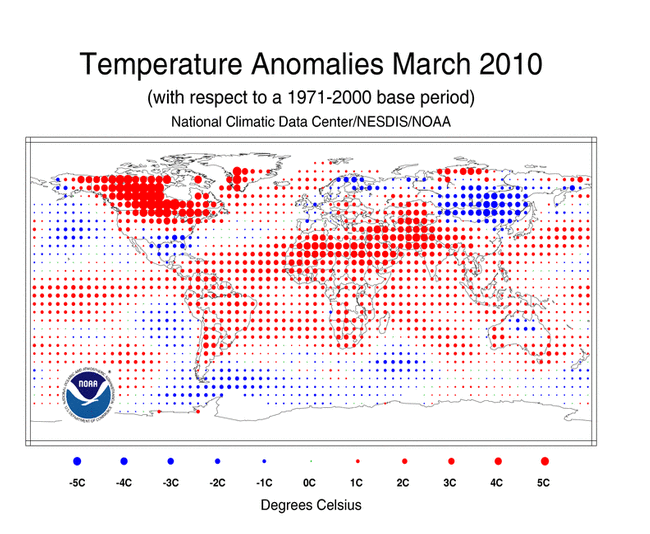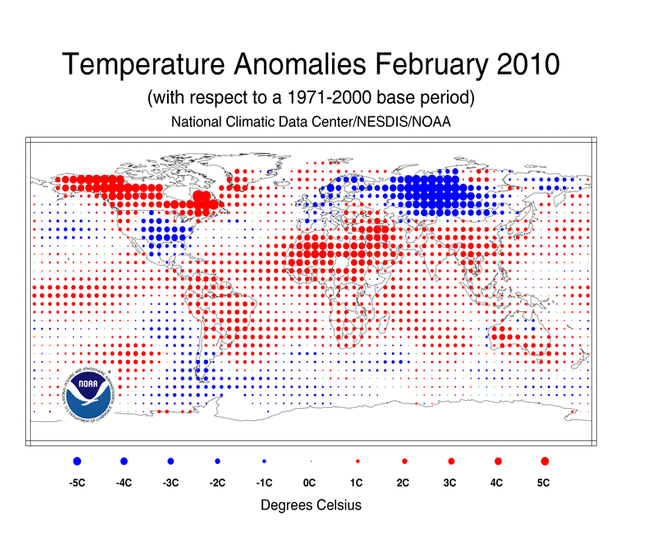Global Highlights (From
the National Climatic Data Center)
NOVEMBER 2010:
- The combined global land and ocean average
surface temperature for November 2010 was 0.69°C (1.24°F) above
the 20th century average of 12.9°C (55.2°F). This was
the second warmest such period on record. 2004 was the warmest
November on record.
- The combined global land and ocean average
surface temperature for fall (September–November) 2010 was the
sixth warmest on record for the season, 0.58°C (1.04°F) above
the 20th century average of 14.0°C (57.1°F).
- For the 2010 year-to-date (January–November),
the combined global land and ocean surface temperature was
0.64°C (1.15°F) above the 20th century average—the
warmest such period since records began in 1880.
- The November 2010 Northern Hemisphere land and
ocean surface temperature was the warmest November on record,
while the Southern Hemisphere land and ocean surface temperature
was the 13th warmest November on record.
- The November 2010 global land surface
temperature was the warmest on record, at 1.52°C (2.74°F) above
the 20th century average, while the November global
ocean temperature tied with 1987 and 2008 as the tenth warmest
on record, at 0.39°C (0.70°F) above average.
OCTOBER 2010:
- The combined global land and ocean surface
temperature for October 2010 was 0.54°C (0.97°F) above the 20th
century average of 14.0°C (57.1°F) and was the eighth warmest on
record. October 2003 is the warmest October on record.
- The October worldwide land surface temperature
was 0.91°C (1.64°F) above the 20th century average of
9.3°C (48.7°F)—the sixth warmest October on record.
- The October worldwide ocean surface temperature
was 0.40°C (0.72°F) above the 20th century average of
15.9°C (60.6°F) and was the tenth warmest October on record.
- For January–October 2010, the global combined
land and ocean surface temperature was 0.63°C (1.13°F) above the
20th century average of 14.1°C (57.4°F) and tied with
1998 as the warmest January–October period on record.
SEPTEMBER 2010:
- The combined global land and ocean surface
temperature for September 2010 was 0.50°C (0.90°F) above the 20th
century average of 15.0°C (59.0°F) and tied with 1998 as the
eighth warmest on record. September 2005 is the warmest
September on record.
- The September worldwide land surface
temperature was 0.66°C (1.19°F) above the 20th
century average of 12.0°C (53.6°F)—the ninth warmest September
on record.
- The September worldwide ocean surface
temperature was 0.44°C (0.79°F) above the 20th
century average of 16.2°C (61.1°F) and tied with 1998 and 2008
as the ninth warmest September on record.
AUGUST 2010:
- The combined global land and ocean surface
temperature for August 2010 was the third warmest on record at
16.2°C (61.2°F), which is 0.60°C (1.08°F) above the 20th
century average of 15.6°C (60.1°F). August 1998 is the warmest
August on record and 2009 is the second warmest.
- The August worldwide land surface temperature
was 0.90°C (1.62°F) above the 20th century average of
13.8°C (56.9°F)—the second warmest August on record, behind
1998.
- The worldwide ocean surface temperature was
0.50°C (0.90°F) above the 20th century average of
16.4°C (61.4°F) and tied with 1997 as the sixth warmest August
on record.
JULY 2010:
- The combined global land and ocean average
surface temperature for July 2010 was the second warmest on
record, behind 1998, at 16.5°C (61.6F), which is 0.66°C (1.19°F)
above the 20th century average of 15.8°C (60.4°F).
- The July worldwide land surface temperature was
1.03°C (1.85°F) above the 20th century average of
14.3°C (57.8°F)—the warmest July on record.
- The worldwide ocean surface temperature was
0.54°C (0.97°F) above the 20th century average of
16.4°C (61.5°F) and the fifth warmest July on record. The warmth
was most pronounced in the Atlantic Ocean.
- La Niña conditions developed during July 2010,
as sea surface temperatures (SST) continued to drop across the
central and eastern equatorial Pacific Ocean. According to
NOAA's Climate Prediction Center, La Niña is expected to
strengthen and last through the Northern Hemisphere winter
2010-2011.
- For the year-to-date, the global combined land
and ocean surface temperature of 14.5°C (58.1°F) was the warmest
January-July period on record. This value is 0.68°C (1.22°F)
above the 20th century average.
JUNE 2010:
Global Highlights
- The combined global land and ocean average
surface temperature for June 2010 was the warmest on record at
16.2°C (61.1°F), which is 0.68°C (1.22°F) above the 20th
century average of 15.5°C (59.9°F). The previous record for June
was set in 2005.
- June 2010 was the fourth consecutive warmest
month on record (March, April, and May 2010 were also the
warmest on record). This was the 304th consecutive
month with a global temperature above the 20th
century average. The last month with below-average temperature
was February 1985.
- The June worldwide averaged land surface
temperature was 1.07°C (1.93°F) above the 20th
century average of 13.3°C (55.9°F)—the warmest on record.
-
Sea surface temperature (SST) anomalies in
the central and eastern equatorial Pacific Ocean continued to
decrease during June 2010. According to
NOAA's Climate Prediction
Center, La Niña conditions are likely to develop during the
Northern Hemisphere summer 2010.
MAY 2010:
Global Highlights
- The combined global land and ocean average
surface temperature for May 2010 was 0.69°C (1.24°F) above the
20th century average of 14.8°C (58.6°F). This is the
warmest such value on record since 1880.
- For March–May 2010, the combined global land
and ocean surface temperature was 14.4°C (58.0°F) — the warmest
March-May on record. This value is 0.73°C (1.31°F) above the 20th
century average.
- The combined global land and ocean average
surface temperature for January–May 2010 was the warmest on
record. The year-to-date period was 0.68°C (1.22°F) warmer than
the 20th century average.
- The worldwide ocean surface temperature for May
2010 was the second warmest May on record, behind 1998, 0.55°C
(0.99°F) above the 20th century average of 16.3°C
(61.3°F).
- The seasonal (March–May 2010) worldwide ocean
surface temperature was the second warmest such period on
record, 0.55°C (0.99°F) above the 20th century
average of 16.1°C (61.0°F).
- The global land surface temperatures for May
and the March–May period were the warmest on record, at 1.04°C
(1.87°F) and 1.22°C (2.20°F) above the 20th century
average, respectively.
- In the Northern Hemisphere, both the May 2010
average temperature for land areas, and the hemisphere as a
whole (land and ocean surface combined), represented the warmest
May on record. The Northern Hemisphere ocean temperature was the
second warmest May on record. The average combined land and
ocean surface temperature for the Northern Hemisphere was also
record warmest for the March–May period.
- El Niño ended during May 2010. Sea surface temperature
anomalies in the eastern equatorial Pacific Ocean cooled below
the El Niño threshold, signifying a return to ENSO-neutral
conditions. According to
NOAA's Climate Prediction Center, sea surface cooling could
result in a La Niña during the Northern Hemisphere summer 2010.
APRIL 2010:
- The combined global land and ocean average
surface temperature for April 2010 was the warmest on record at
14.5°C (58.1°F), which is 0.76°C (1.37°F) above the 20th
century average of 13.7°C (56.7°F). This was also the 34th
consecutive April with global land and ocean temperatures above
the 20th century average.
- The worldwide ocean surface temperature was
0.57°C (1.03°F) above the 20th century average of
16.0°C (60.9°F) and the warmest April on record. The warmth was
most pronounced in the equatorial portions of the major oceans,
especially the Atlantic.
- The April worldwide land surface temperature
was 1.29°C (2.32°F) above the 20th century average of
8.1°C (46.5 °F)—the third warmest on record.
MARCH 2010:
The combined global land and ocean average surface
temperature for March 2010 was the warmest on record at 13.5°C (56.3°F),
which is 0.77°C (1.39°F) above the 20th century average of
12.7°C (54.9°F). This was also the 34th consecutive March
with global land and ocean temperatures above the 20th
century average.
The March worldwide land surface temperature was
1.36°C (2.45°F) above the 20th century average of 5.0°C
(40.8°F)—the fourth warmest on record.
The worldwide ocean surface temperature was
0.56°C (1.01°F) above the 20th century average of 15.9°C
(60.7°F) and the warmest March on record.
FEBRUARY 2010:
The combined global land and ocean average surface
temperature for February 2010 was 0.60°C (1.08°F) above the 20th
century average of 12.1°C (53.9°F). This is the sixth warmest such
value on record.
The worldwide ocean surface temperature for February 2010 was the
second warmest on record for February, 0.54°C (0.97°F) above the 20th
century average of 15.9°C (60.6°F).
In the Southern Hemisphere, both the February 2010 average
temperature for land areas and the Hemisphere as a whole (land and
ocean surface combined), represented the warmest February on record.
The Southern Hemisphere ocean temperature tied with 1998 as the
warmest February on record.
JANUARY 2010:
The combined global land and ocean
average surface temperature for January 2010 was 0.60°C (1.08°F) above
the 20th
century average of 12.0°C (53.6°F). This is the fourth warmest
January on record.
The global land surface temperature for January
2010 was 0.83°C (1.49°F) above the 20th century average
of 2.8°C (37.0°F)—the twelfth warmest January on record. Land areas
in the Southern Hemisphere were the warmest on record for January.
In the Northern Hemisphere, which has much more land, comparatively,
land surface temperatures were 18th warmest on record.
The worldwide ocean surface temperature for January
2010 was the second warmest—behind 1998—on record for January,
0.52°C (0.94°F) above the 20th century average of 15.8°C
(60.5°F). This can be partially attributed to the persistence of El
Niño across the equatorial Pacific Ocean. According to NOAA's
Climate Prediction Center (CPC), El Niño is expected to continue
through the Northern Hemisphere spring 2010.
|



















